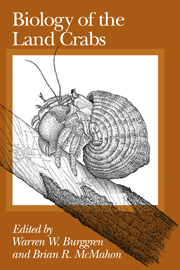Book contents
- Frontmatter
- Contents
- List of contributors
- Preface
- 1 BIOLOGY OF THE LAND CRABS: AN INTRODUCTION
- 2 EVOLUTION, SYSTEMATICS, AND GEOGRAPHICAL DISTRIBUTION
- 3 ECOLOGY
- 4 BEHAVIOR
- 5 REPRODUCTION AND DEVELOPMENT
- 6 GROWTH AND MOLTING
- 7 ION AND WATER BALANCE
- 8 RESPIRATION
- 9 CIRCULATION
- 10 ENERGETICS AND LOCOMOTION
- 11 EPILOGUE
- APPENDIX: Natural histories of selected terrestrial crabs
- References
- Author index
- Systematic index
- Subject index
2 - EVOLUTION, SYSTEMATICS, AND GEOGRAPHICAL DISTRIBUTION
Published online by Cambridge University Press: 04 August 2010
- Frontmatter
- Contents
- List of contributors
- Preface
- 1 BIOLOGY OF THE LAND CRABS: AN INTRODUCTION
- 2 EVOLUTION, SYSTEMATICS, AND GEOGRAPHICAL DISTRIBUTION
- 3 ECOLOGY
- 4 BEHAVIOR
- 5 REPRODUCTION AND DEVELOPMENT
- 6 GROWTH AND MOLTING
- 7 ION AND WATER BALANCE
- 8 RESPIRATION
- 9 CIRCULATION
- 10 ENERGETICS AND LOCOMOTION
- 11 EPILOGUE
- APPENDIX: Natural histories of selected terrestrial crabs
- References
- Author index
- Systematic index
- Subject index
Summary
Introduction
At the outset of this chapter two points must be clarified in order to define the limits of coverage: first, which taxa are to be accepted as “crabs, ” and second, which characteristics will qualify members of those taxa for consideration as “land” crabs.
Here, in discussing the taxonomic limits, and in later sections of this chapter, I have followed the classification of the Crustacea developed by Bowman and Abele (1982) in the most recent major review of crustacean biology. This will be convenient, although later in this chapter it will become clear that this classification is certainly not ideal in all respects (see section 4). However, in the currently uncertain state of brachyuran phylogeny an additional different scheme might only increase confusion. The relevant parts of Bowman and Abele's classification are reproduced in Table 2.1. The eleven families of the Potamoidea are listed, but since the subdivision of that superfamily is still to some extent uncertain, the families are not mentioned further in this chapter. A case could be made for restricting coverage to the Brachyura or “true crabs, ” but this would exclude the land hermit crabs: These show terrestrial adaptations very similar to the true crabs, and a comprehensive treatment demands their inclusion. The simplest solution is to extend consideration to the infraorders Anomura and Brachyura. The Anomura is used in a rather more restricted sense by Bowman and Abele (1982) than in some previous classifications.
- Type
- Chapter
- Information
- Biology of the Land Crabs , pp. 6 - 54Publisher: Cambridge University PressPrint publication year: 1988
- 90
- Cited by



